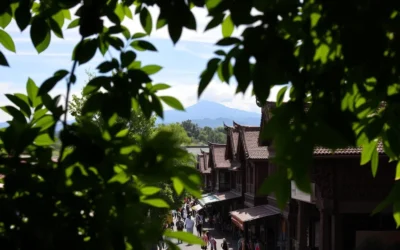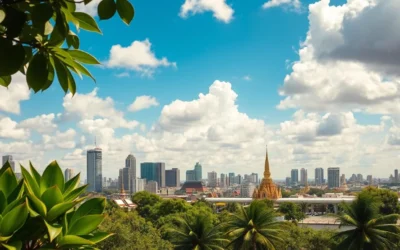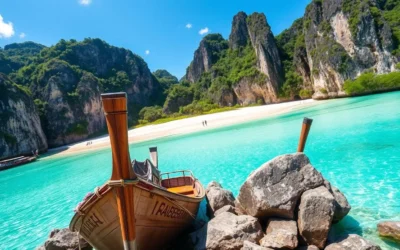Are you ready to escape to a tropical paradise? With over 300 sunny days annually, Koh Tao is an ideal destination for beach lovers and diving enthusiasts. Located in the Gulf of Thailand, this island boasts crystal-clear waters, vibrant marine life, and world-class diving opportunities.
Understanding the weather patterns is crucial for planning your trip. The island experiences two distinct seasons: a dry season from March to October and a monsoon season from November to January. The dry season offers warm tropical weather, with average temperatures ranging from 25-35°C, making it perfect for outdoor activities.
This guide will help you determine the best time to visit based on your preferences for weather, activities, crowds, and budget. Whether you’re looking to get PADI certified or simply relax on pristine beaches, knowing when to visit can make all the difference in your trip to this Thai island gem.
Understanding Koh Tao’s Tropical Climate
Tropical climate defines Koh Tao, making it a distinct destination in Thailand’s diverse geographical landscape. Located in the Gulf of Thailand, Koh Tao’s weather patterns are influenced by its maritime position, creating a unique climate that differs from the mainland.
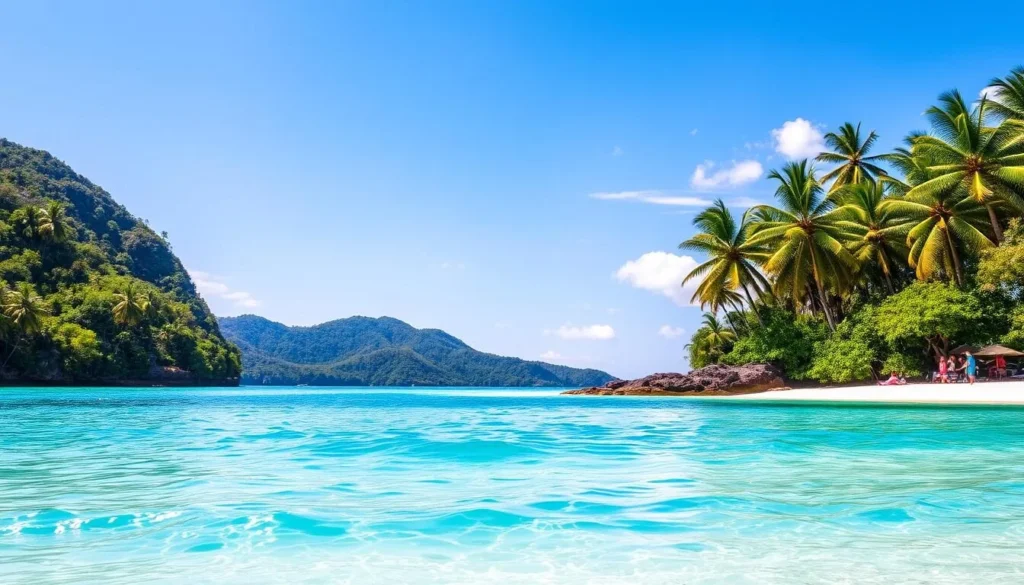
The Two Main Seasons: Dry and Monsoon
Koh Tao experiences a simplified version of Thailand’s climate, with two main seasons: dry and monsoon. The dry season, which runs from March to October, is characterized by sunny skies and minimal rainfall, making it the ideal time for outdoor activities like diving and snorkeling. In contrast, the monsoon season, from November to February, brings increased rainfall and rougher seas. However, the rain showers during this period are often short and followed by sunshine, and the island takes on a lush, green appearance.
- The dry season offers optimal conditions for water sports and activities.
- The monsoon season, while wetter, can still offer pleasant weather interspersed with rain.
How Koh Tao’s Weather Differs from Mainland Thailand
Koh Tao’s weather patterns differ significantly from mainland Thailand due to its island location in the Gulf of Thailand. Unlike the mainland, which typically experiences three distinct seasons (hot, rainy, and cool), Koh Tao primarily follows a two-season pattern of dry and monsoon. The island shares similar weather patterns with nearby islands like Koh Samui, but differs from Andaman Sea islands like Phuket, which have their wettest months from April to October.
Key differences include:
- Koh Tao’s monsoon season runs from November to January, contrasting with the mainland’s rainy season from May to October.
- The island is sheltered from extreme weather conditions that affect other parts of Thailand.
- Koh Tao doesn’t experience the extreme heat (40°C+) that central Thailand faces during March to May.
Koh Tao, Thailand: Best Months for a Weather-Savvy Trip
For those planning a trip to Koh Tao, understanding the island’s weather patterns is key to enjoying the best that this Thai island has to offer. The island experiences a tropical climate, characterized by two main seasons: the dry season and the monsoon season.
March to October: The Ideal Dry Season
The dry season, spanning from March to October, is considered the ideal time to visit Koh Tao. During these months, the weather is typically sunny, with minimal rainfall, making it perfect for diving and other outdoor activities. The calm seas and clear waters offer excellent visibility for exploring the island’s rich marine life.
- The dry season brings consistent warm weather, ideal for beach activities and island hopping.
- With clear skies, the conditions are perfect for snorkeling and diving, offering a glimpse into Koh Tao’s vibrant underwater world.
- This period attracts more visitors, so you can expect a lively atmosphere across the island.
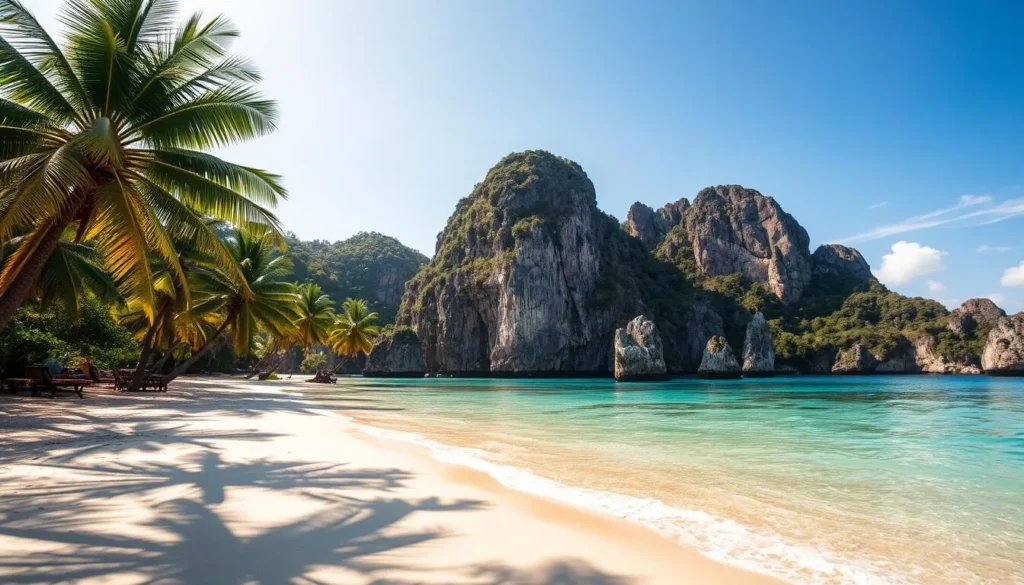
November to February: Navigating the Monsoon Season
The monsoon season, from November to February, brings a different experience to Koh Tao. While there’s more rainfall and rougher seas, this period also has its advantages, particularly for budget travelers. You can enjoy lower accommodation prices and fewer crowds, making for a more relaxed atmosphere.
| Month | Rainfall | Diving Conditions | Accommodation Prices |
|---|---|---|---|
| November | High | Limited visibility | Lower |
| December | High | Limited visibility | Lower |
| January | Moderate | Improving visibility | Low |
| February | Moderate | Improving visibility | Low |
For those who are flexible with their plans, the monsoon season can offer a unique experience of Koh Tao, with lush landscapes and dramatic skies providing a different but equally captivating perspective of the island.
Month-by-Month Weather Guide to Koh Tao
Planning a trip to Koh Tao requires a good understanding of its monthly weather conditions. The island’s tropical climate means that the weather varies significantly throughout the year, impacting activities such as diving and beach relaxation.
January to March: End of Monsoon to Early Dry Season
January marks the end of the monsoon season in Koh Tao, with the weather gradually transitioning to the dry season. You can expect:
- Decreasing rainfall
- Temperatures ranging from 24-28°C (75-82°F)
- Improving diving conditions as the seas calm down
By March, the dry season is well established, with plenty of sunshine and minimal rain. It’s an excellent time for outdoor activities, with comfortable temperatures and calm seas.
April to June: Peak Dry Season Conditions
The months from April to June are characterized by peak dry season conditions in Koh Tao. You can expect:
- Abundant sunshine with very little rainfall
- Warm temperatures, typically between 28-32°C (82-90°F)
- Excellent diving conditions, with clear waters and abundant marine life
This period is ideal for beach activities and water sports, making it a popular time among visitors.
July to September: Late Dry Season
July to September continues the dry season trend in Koh Tao, with:
- Persistent warm weather, often reaching highs of 30°C (86°F)
- Low humidity and plenty of sunshine
- Optimal conditions for diving and snorkeling
The dry season ensures that the island remains vibrant, with many outdoor activities available.
October to December: Monsoon Season
October signals the transition from the dry season to the monsoon season. You can expect:
| Month | Temperature Range (°C) | Rainfall |
|---|---|---|
| October | 26-30 | Low rain, transitioning to monsoon |
| November | 25-29 | Increasing rain, shoulder month transition |
| December | 24-28 | Heavy rain periods, peak monsoon season |
During these months, the rain typically comes in intense bursts rather than continuous drizzle, leaving parts of the day sunny. The monsoon season brings fewer visitors, resulting in lower prices for accommodations and activities, making it an excellent time for budget travelers.
Despite the rain, the island transforms into a lush, green landscape, offering a different but equally beautiful perspective of Koh Tao.
Diving Conditions Throughout the Year

Koh Tao’s dive sites are affected by the island’s tropical climate, resulting in diverse diving experiences throughout the year. The island offers over 25 dive sites, each with its unique characteristics and accessibility varying throughout the year based on weather conditions and sea state.
Visibility and Marine Life by Season
The dry season, from March to October, is characterized by calm seas and excellent visibility, often exceeding 20 meters. This period is ideal for spotting marine life, including whale sharks at Chumphon Pinnacle, one of Koh Tao’s premier dive sites. Visibility is at its best during the dry season, making it perfect for both beginner and experienced divers.
In contrast, the monsoon season brings rougher seas and reduced visibility. However, sheltered locations like Japanese Gardens and Twins remain accessible, offering a different diving experience with the chance to see unique marine life.
Best Dive Sites Based on Weather Conditions
Different dive sites in Koh Tao are suited to various weather conditions. For instance, Sail Rock is best accessed during the dry and hot seasons when seas are calmer for the longer boat journey. On the other hand, Green Rock is suitable for diving in all seasons due to its proximity to the shore.
- During the dry season, all dive sites are typically accessible, including Sail Rock.
- Monsoon season limits access to some sites, but sheltered locations remain diveable.
- Chumphon Pinnacle is best visited during the dry season for optimal visibility.
- Southwest Bay sites are more weather-dependent and best visited during calm periods.
Understanding the seasonal variations in diving conditions can help you plan your trip to Koh Tao and make the most of your diving experience.
Beach Activities and Weather Considerations
As you plan your trip to Koh Tao, understanding how the weather affects your beach activities is crucial. The island offers a variety of activities beyond diving, including snorkeling, paddleboarding, kayaking, sailing, and fishing, all of which are influenced by the seasonal weather patterns.
Best Beaches for Different Weather Conditions
Koh Tao’s beaches are a major draw, but the weather can significantly impact your beach experience. During the dry season (March to October), the calm seas and clear waters make it ideal for water activities. Sairee Beach is popular throughout the year, but afternoon rain showers during the monsoon season may interrupt play.
| Weather Conditions | Best Beaches | Activities |
|---|---|---|
| Calm Seas (Dry Season) | Sairee Beach, Mae Haad Beach | Snorkeling, Paddleboarding, Kayaking |
| Rough Seas (Monsoon Season) | Shalawaw Beach, Chalok Baan Khao Beach | Beachcombing, Relaxation |

Water Sports and Weather Dependencies
The weather in Koh Tao significantly affects water sports. Snorkeling is excellent year-round, but visibility is best during the dry season. Paddleboarding and kayaking are most enjoyable during calm sea conditions, typically in the early morning. Sailing and boat tours operate mainly during the dry season, while fishing trips are available year-round but are more reliable during stable weather conditions.
- Snorkeling: Best visibility during dry season (March-October)
- Paddleboarding and Kayaking: Most enjoyable during calm seas, early morning
- Sailing and Boat Tours: Primarily during dry season (March-October)
- Fishing Trips: Available year-round, more reliable during dry season
Traveling to Koh Tao During Shoulder Months
Visiting Koh Tao during the shoulder months can be a strategic decision for travelers looking to balance weather and cost. The shoulder season, which includes months like February and November, offers a unique blend of advantages for visitors.
February: Transitioning from Monsoon to Dry Season
February marks the transition from the monsoon season to the dry season in Koh Tao. During this month, the island starts to experience fewer rain showers, and the weather gradually becomes more pleasant. You can expect temperatures to rise, making it ideal for outdoor activities like diving and snorkeling. As the month progresses, the sea conditions improve, and the visibility underwater becomes clearer. With the decrease in rainfall, the island becomes more accessible, and the lush greenery from the monsoon season is still present, making the scenery particularly beautiful.
November: Transitioning from Dry to Monsoon Season
November is another shoulder month that represents the transition from the dry season to the monsoon season. The month begins with relatively dry conditions, but as it progresses, the rainfall increases, and the weather becomes more unpredictable. Despite the increasing rain, temperatures remain pleasant, ranging from 25-29°C (77-84°F), making it still suitable for beach activities. The island is less crowded compared to the peak months, and you can enjoy lower accommodation prices, with many resorts offering “green season” discounts of 30-50%. Early November is still good for diving, with visibility reaching 15-20 meters on good days, although conditions become more variable later in the month.
| Month | Weather Conditions | Visitor Numbers | Accommodation Prices |
|---|---|---|---|
| February | Transitioning to dry season, fewer rain showers | Moderate | Moderate |
| November | Transitioning to monsoon season, increasing rainfall | Low | Lower due to “green season” discounts |

Weather Impact on Accommodation Options

Koh Tao’s accommodation landscape is significantly influenced by the island’s weather patterns throughout the year. As a result, understanding the seasonal changes is crucial for making informed decisions about where to stay.
Beachfront vs. Hillside Stays During Different Seasons
The choice between beachfront and hillside accommodations in Koh Tao largely depends on the season. During the dry season, beachfront properties are ideal for enjoying the island’s renowned beaches. In contrast, hillside stays might be preferable during the monsoon season as they often provide better views and potentially drier conditions.
Seasonal Pricing Fluctuations
Accommodation prices on Koh Tao fluctuate significantly with the seasons. Peak season, typically from December to April, commands the highest prices, with rates 30-50% higher than during the low season. The monsoon months, particularly November and December, offer the best value, with many resorts discounting rates by 30-50% to attract visitors. Shoulder months like February and October provide excellent value with moderate pricing.
Budget travelers can particularly benefit from visiting during the monsoon season, not just because of lower accommodation prices but also due to fewer crowds. Many accommodations offer longer-stay discounts during this period, making it an excellent time for digital nomads or those with flexible schedules.
Transportation Considerations Based on Weather
Understanding transportation options to Koh Tao is crucial, especially during the monsoon season when weather conditions can be unpredictable. You need to be aware of the available transportation methods and their reliability during different weather conditions to plan your trip effectively.
Ferry and Boat Services During Monsoon Season
During the monsoon season, ferry and boat services to Koh Tao may be disrupted due to rough seas and strong winds. While services like the high-speed catamaran operate on a reduced schedule, some services might be canceled altogether. It’s essential to check with ferry operators in advance for the latest information on schedules and potential disruptions.
Best Transportation Options During Dry Season
The dry season, from March to October, offers the most reliable transportation options to and from Koh Tao. During this period, ferry services operate on regular schedules, with multiple daily departures from Chumphon, Surat Thani, Koh Samui, and Koh Phangan. High-speed catamaran services are particularly convenient, reducing travel time significantly during calm sea conditions.
Local longtail boats and taxi boats also provide regular services around the island, making it easy to explore remote beaches. Motorbike rentals become a more practical option during the dry season due to safer road conditions.
Planning for Unpredictable Weather
Unpredictable weather is a reality in Koh Tao, but with the right planning, you can still have a great time on the island. The key to enjoying your trip is being prepared for the varying weather conditions that Koh Tao experiences throughout the year.
Essential Packing List for Different Seasons
When packing for your trip to Koh Tao, it’s crucial to consider the season you’re visiting in. For the dry season, lightweight and breathable clothing is ideal, while the monsoon season requires waterproof gear and quick-drying clothes. Regardless of the season, sun protection is a must, including sunscreen, a hat, and sunglasses.
| Season | Clothing | Accessories |
|---|---|---|
| Dry Season | Lightweight, breathable | Sunscreen, hat, sunglasses |
| Monsoon Season | Waterproof, quick-drying | Rain jacket, waterproof bags |
Indoor Activities for Rainy Days
While Koh Tao is known for its outdoor attractions, the island offers several engaging indoor activities for rainy days. You can take advantage of rainy day specials at dive centers for theory classes and video sessions, or practice yoga at one of the many studios across the island. Additionally, you can indulge in Thai cooking classes, learn about the local culture, and enjoy massage and spa treatments at discounted rates during the monsoon season.
- Many dive centers offer rainy day specials on theory classes and video sessions.
- Numerous yoga studios across the island offer daily classes in covered spaces.
- Thai cooking classes are available at several restaurants and resorts.
- Many spas offer discounted rates during monsoon season.

Crowd Levels and Weather Correlation
Understanding the correlation between crowd levels and weather patterns is crucial for planning an ideal trip to Koh Tao. The island’s weather significantly influences the number of visitors it receives throughout the year.

Peak Tourist Seasons vs. Weather Patterns
The peak tourist season in Koh Tao typically aligns with the dry season, from March to October, when the weather is most favorable. During these months, especially in July and August, the island is bustling with visitors. The dry and sunny conditions make it an ideal time for diving and other outdoor activities, attracting a large number of tourists.
In contrast, the monsoon season, which spans from November to February, sees a significant decrease in visitor numbers due to the unpredictable weather and rougher seas. However, the shoulder months, such as February and November, offer a transition period with fewer crowds and relatively pleasant weather.
Finding the Sweet Spot: Good Weather with Fewer Crowds
For travelers seeking a balance between favorable weather and manageable crowd levels, certain periods offer the best of both worlds. February stands out as an ideal month to visit Koh Tao, with improving weather conditions, good diving visibility, and fewer visitors. Similarly, early May and late September/early October are excellent periods with fewer crowds, just before and after the European summer holiday periods.
To avoid crowds, consider visiting during weekdays instead of weekends. Additionally, avoiding the days around Full Moon Parties on neighboring Koh Phangan can significantly reduce the number of visitors on Koh Tao. For diving enthusiasts, scheduling trips during weekdays in shoulder seasons provides smaller dive groups and more attentive instruction. Accommodation prices during these periods typically fall 15-30% below peak rates, offering excellent value for money.
Budget Considerations Across Seasons
When planning your trip to Koh Tao, understanding the budget implications across different seasons is crucial. The island’s pricing fluctuates significantly throughout the year, impacting various aspects of your vacation.
Price Differences Between High and Low Seasons
The high season, typically from December to April, comes with higher prices for accommodations, diving courses, and other activities. In contrast, the low season, which includes months like November, offers substantial discounts. For instance, monthly rental rates can drop by 50% or more during the low season compared to the peak months.
| Season | Accommodation Prices | Diving Course Prices |
|---|---|---|
| High Season (Dec-Apr) | Higher | Higher |
| Low Season (May-Nov) | Lower | Competitive pricing |
Value-for-Money Periods to Visit
For travelers seeking maximum value, certain periods stand out. Late February to early March and October are considered sweet spots, offering good weather conditions and pre-peak or post-peak season pricing. Additionally, package deals during shoulder seasons, like May-June and September-October, provide excellent value, especially for diving courses.

By carefully choosing when to visit Koh Tao, you can enjoy a more affordable and rewarding vacation experience.
Health and Safety Weather Considerations
Koh Tao’s weather can significantly impact your health and safety, making it essential to be prepared for the conditions you may face during your visit. Understanding the implications of the island’s tropical climate is crucial for a safe and enjoyable trip.
Sun Protection During Dry Season
During the dry season, protecting yourself from the sun is paramount. Use a broad-spectrum sunscreen with a high SPF, wear protective clothing, and don’t forget a hat and sunglasses to shield yourself from the intense tropical sun. Staying hydrated is also crucial, so drink plenty of water throughout the day.
Monsoon Season Safety Tips
The monsoon season brings its own set of challenges, including heavy rain and potential storms. Be cautious when traveling by boat, and check weather forecasts before ferry journeys. On land, be mindful of slippery roads, especially if you’re riding a motorbike. It’s also wise to have a flexible itinerary to accommodate any weather-related disruptions.
| Safety Consideration | Dry Season | Monsoon Season |
|---|---|---|
| Sun Protection | High SPF sunscreen, protective clothing | Less critical, but still important |
| Road Safety | Generally safe, watch for pedestrians | Slippery roads, cautious motorbike riding |
| Water Activities | Safe conditions for diving and snorkeling | Avoid during strong currents and storms |
Special Events and Weather-Dependent Festivals
Koh Tao, a gem in the Gulf of Thailand, is known for its vibrant events and festivals that are deeply connected to the island’s weather patterns. As you plan your visit, understanding how the weather influences these celebrations can enhance your experience.
Annual Celebrations Worth Planning Around
The island hosts several annual events that are worth planning your trip around. For instance, Songkran (Thai New Year) in mid-April is a highlight, with water fights that are particularly refreshing during the hot weather. The Koh Tao Festival in June celebrates the island’s diving culture with beach cleanups and parties, taking advantage of the reliable dry season weather.
- Songkran in April: Water fights and celebrations during the hottest time of the year.
- Koh Tao Festival in June: Celebrates diving culture with environmental activities and parties.
- Loy Krathong in November: The Festival of Lights, with floating lanterns during breaks in the monsoon rain.
- Save Koh Tao Festival: An environmental conservation event during the dry season.
- Full Moon Parties on neighboring Koh Phangan: Influences visitor patterns year-round.
- Christmas and New Year: Festive celebrations across the island, even during the monsoon season.
- Underwater Metal Festival: A unique event for certified divers during peak diving conditions.
These events not only add to the island’s charm but also provide unique experiences for visitors. By timing your tour to Koh Tao around these events, you can enjoy the island’s culture and activities to the fullest, while also experiencing the best of its weather and activities.
Conclusion: Creating Your Perfect Weather-Savvy Koh Tao Itinerary
Koh Tao’s tropical climate means that the time of year you visit can significantly impact your vacation. Understanding the weather patterns is essential for planning the perfect diving vacation or beach getaway.
When planning your trip, consider balancing your activity preferences, budget considerations, and tolerance for weather variables. For instance, if you’re a first-time visitor, April through September offers the best overall experience with minimal rainfall and optimal diving conditions.
Budget-conscious travelers may find February or October ideal for a balance between favorable weather and value. Meanwhile, diving enthusiasts should prioritize March through August for the best visibility. Whatever season you choose, building flexibility into your itinerary allows you to adapt to changing weather conditions and make the most of your Koh Tao experience.
Ultimately, each season on Koh Tao offers its unique charm, from the vibrant atmosphere of high season to the tranquility of monsoon months. By choosing the right time for your preferences, you can create a memorable vacation on this beautiful island.
—
The above is subject to change.
Check back often to TRAVEL.COM for the latest travel tips and deals.


